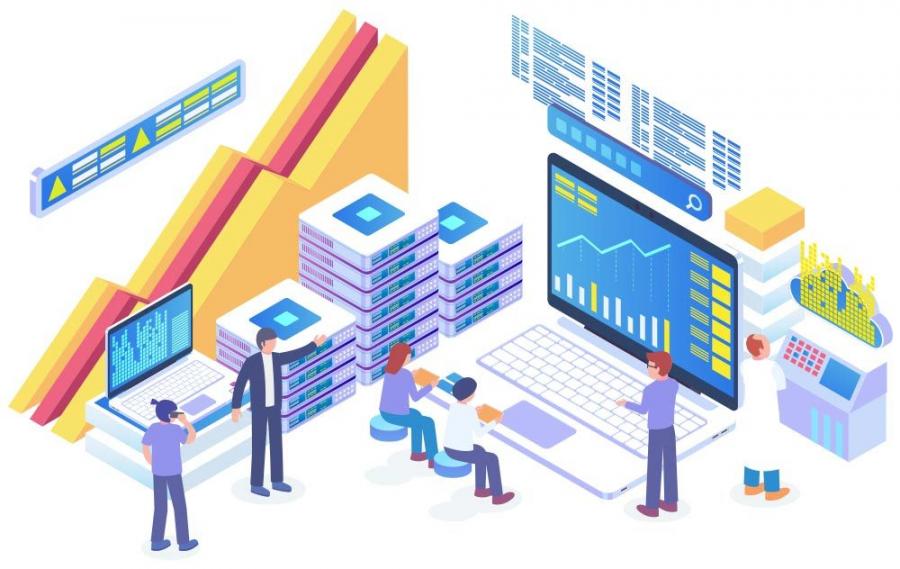Energy consumption of a data center

How much energy do Data Centers use?
Data centers can be thought of as the “brains” of the internet. Their role is to process, store, and communicate the data behind the myriad information services we rely upon every day, whether it be streaming video, email, social media, online collaboration, or scientific computing.
Data centers utilize different information technology (IT) devices to provide these services, all of which are powered by electricity. Servers provide computations and logic in response to information requests, while storage drives house the files and data needed to meet those requests. Network devices connect the data center to the internet, enabling incoming and outgoing data flows. The electricity used by these IT devices is ultimately converted into heat, which must be removed from the data center by cooling equipment that also runs on electricity.
On average, servers and cooling systems account for the greatest shares of direct electricity use in data centers, followed by storage drives and network devices (See figure 1). Some of the world’s largest data centers can each contain many tens of thousands of IT devices and require more than 100 megawatts (MW) of power capacity—enough to power around 80,000 U.S. households (U.S. DOE 2020).

As the number of global internet users has grown, so too has demand for data center services, giving rise to concerns about growing data center energy use. Between 2010 and 2018, global IP traffic—the quantity of data traversing the internet—increased more than ten-fold, while global data center storage capacity increased by a factor of 25 in parallel (Masanet et al. 2020). Over the same time period, the number of compute instances running on the world’s servers—a measure of total applications hosted—increased more than six-fold (see Figure 3)

These strong growth trends are expected to continue as the world consumes more and more data. And new forms of information services such as artificial intelligence (AI), which are particularly computationally-intensive, may accelerate demand growth further. Therefore, the ability to quantify and project data center energy use is a key energy and climate policy priority.
Data center energy use estimates: A tale of two methods
Official statistics are not currently compiled on data center energy use at national or global levels. Therefore, mathematical models must be used to estimate this energy use. So-called “bottom-up” models account for the installed stocks of IT devices in different data centers and their energy use characteristics to arrive at an estimate of total energy use. While bottom-up studies offer many insights into the drivers of energy use, they are also very data and time intensive; therefore, they don’t appear often. For example, the most authoritative bottom-up study in the last decade appeared in 2011 (Koomey 2011), and it estimated that data centers accounted for between 1.1 percent and 1.5 percent of global electricity use in 2010.
What about CO2 emissions?
The substantial electricity use of data centers also gives rise to concerns over their carbon dioxide (CO2) emissions. Unfortunately, it is not yet possible to accurately estimate total CO2 emissions, due to a lack of data on the locations of the vast majority of global data centers and the emissions intensities (measured in grams CO2 per kilowatt-hour) of their actual electricity sources. Only a handful of companies, including Google, Apple, Switch, and Facebook publicly report such data, indicating a growing trend among some of the world’s largest data center operators toward renewable energy procurement.
The substantial electricity use of data centers also gives rise to concerns over their carbon dioxide (CO2) emissions. Unfortunately, it is not yet possible to accurately estimate total CO2 emissions, due to a lack of data on the locations of the vast majority of global data centers and the emissions intensities (measured in grams CO2 per kilowatt-hour) of their actual electricity sources. Only a handful of companies, including Google, Apple, Switch, and Facebook publicly report such data, indicating a growing trend among some of the world’s largest data center operators toward renewable energy procurement.
Another recent claim is that “the emissions generated by watching 30 minutes of Netflix (1.6 kg of CO2) is the same as driving almost four miles.” This claim is backed up by assumptions that data centers providing Netflix streaming services would consume around 370 TWh per year (Kamiya 2020). Yet this value is 1.8 times larger than the 205 TWh estimated for all of the world’s data centers combined, which provide society with myriad other information services beyond just streaming Netflix videos.
The path forward
Better modeling capabilities are required for decision makers to confidently evaluate future efficiency and mitigation options, so developing more robust and predictive methods that increase the frequency of bottom-up insights and overcome the limitations of extrapolation-based forecasts are a key priority for the energy analysis community.
Marco